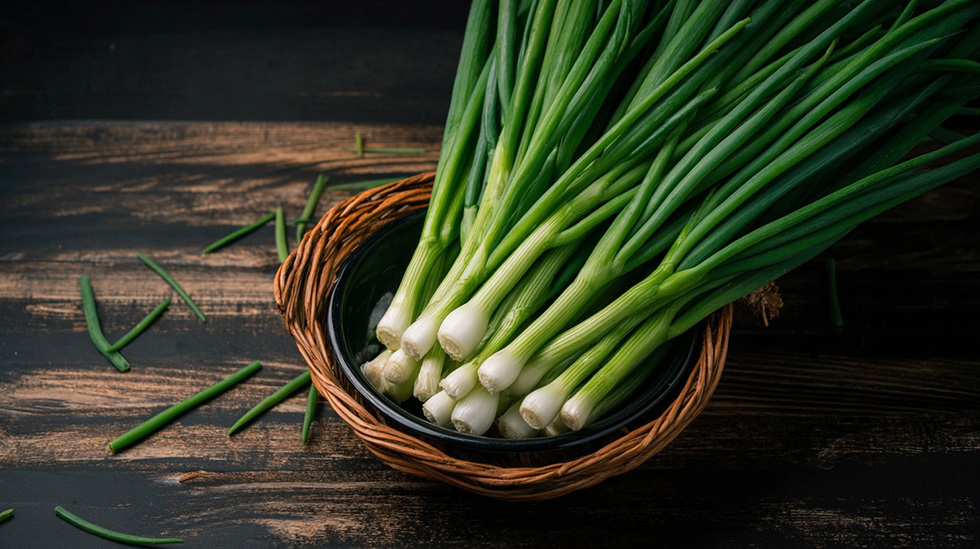A real spring delicacy🧅
The spring onion🧅 is one of the most versatile, easy-to-love vegetables that can be used in any kitchen. The crunchy, slightly spicy little herb is not only a star in salads, it’s also the perfect crunchy snack for a sandwich – and even a friendly guest in your fridge if you know how to handle it. Let’s take a closer look at this charming vegetable!

Spring onions are also known as green onions – depending on which part of the onion you are concentrating on. Latin name Allium cepa var. cepa , a young variety of common onion, harvested before the onion head is fully formed.
Its origins can be traced back to the Middle East and it has been cultivated in various forms for over 5000 years. It was also consumed by the Egyptians, and even then was highly valued for its medicinal properties.
How important is it in the kitchen?
Importance: 4 / 5
Spring onions are not the most talked about vegetable, but they are found in almost every kitchen. It’s an excellent ingredient for both hot and cold dishes, and it’s there when you need something fresh, tasty and crunchy in a hurry to add to a dish. Plus, it doesn’t leave a ‘lingering’ smell like most onions – which is why many people love it. 😄
Which part is edible?
Almost all parts of the onion can be eaten:
- White onion part (bottom part): this is the most flavoursome, slightly spicy, with a crunchy texture. Excellent raw or cooked.
- Green stem (top): also edible, great in salads, soups, pasta.
There are no non-toxic parts, but the leaves are too old and withered to eat – they simply don’t taste good.
What are the health benefits of consuming it?
Spring onions are a real vitamin bomb:
- Rich in vitamin C – supports the immune system
- Contains antioxidants – helps cell protection
- Source of potassium – good for blood pressure
- Contains prebiotic fibre – supports digestion
According to traditional medicine, onions reduce inflammation and help relieve respiratory problems.
Production: where, when, how?
The spring onion season in Europe usually lasts from April to July, but with greenhouse production it is available almost all year round. The main producing countries are:
- Spain – mainly for export, in large quantities
- Netherlands – high quality outdoor growing
- Hungary – domestic crops are mostly marketed in spring and early summer
You are most likely to find domestic goods in the shops from the end of April to June. From autumn to spring, the majority of products on the shelves are imported.
How to choose good quality onions?
Look at the following:
- Colour: bright green stem, white, fresh underside
- Texture: should be firm, crunchy – not slimy or soft
- Leaves: not withered, yellowish
If the green stalk is too limp or has dark spots, leave it.
Storage tips
It is best to:
- In the fridge: in the vegetable crisper, wrapped in plastic or paper bags – keeps fresh for about 5-7 days
- In water: root side down in a glass of water, changed every few days – it will live longer and stay fresh
If you wash it before you put it away, dry it carefully, as moisture promotes spoilage.
Your adventure around the world
Spring onions are an international star:
- China: flavouring for fried noodles, soups, soy sauce dishes
- Mexico: fresh ingredients for tacos, guacamole, salsa
- France: the basis for quiches and sauces
- Hungary: in salads, with egg dishes, with fatty bread 😋
An iconic recipe – Egg noodles with onions
Ingredients:
- 30 dkg flour
- 2 eggs
- approx. 1,5 dl water
- salt
- 4 eggs for the scrambled eggs
- 1 bunch of fresh spring onions
- oil or fat for frying
Preparation:
Mix the noodles, cook in boiling salted water and drain. In a pan, fry the chopped spring onions, then pour the beaten eggs over them and mix with the noodles. There you go – a fresh, Hungarian, oniony treat!
Tips for use in the kitchen
Spring onions are a very flexible raw material. Some ideas:
- Raw in salads
- Freshly cut on top of soups
- In sandwiches, wraps, burgers
- For egg dishes (scrambled eggs, fried eggs, omelette)
Spices that go well with it: parsley, chives, nutmeg, salt, pepper, lemon juice.
What to avoid: don’t use it with too intense spices (e.g. rosemary, cinnamon), as they overpower the flavour.
Summary
Spring onions are a real kitchen hero – discreet but great. It’s easy to recognise, versatile, healthy and doesn’t even completely dominate the kitchen. No wonder it’s loved by so many. If you’ve only been throwing it in your basket now and then, you’ll definitely be doing it more often! 😉🧅
